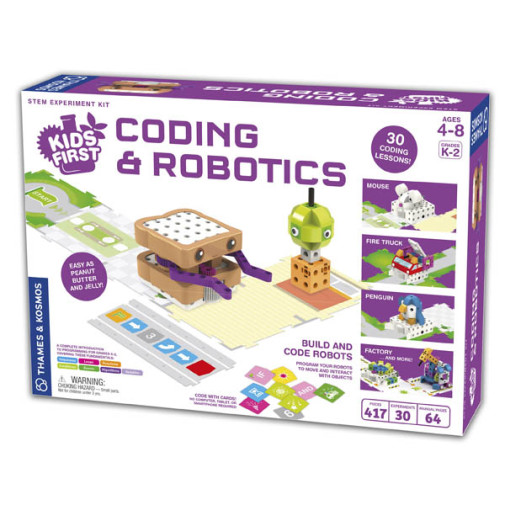We use cookies to make your experience better. To comply with the new e-Privacy directive, we need to ask for your consent to set the cookies. Learn more.
Coding & Robotics (Kids First Level 1)
This introduction to programming doesn't require a tablet or smartphone - all programming is done by laying out a sequence of cardstock "code cards." Sammy, the cute peanut-butter-and-jelly sandwich robot "reads" the code cards and runs the program, with the help of an OID optical scanner. The first programming challenge after assembling Sammy is to create a program to help him visit his friend Hammy the hamburger. The 30 lessons are more serious than the robot names suggest, progressing in complexity and covering sequencing, loops, events, conditionals, functions and variables. Children at the lower end of the age range will need adult help with the lessons, while older children may be able to work independently. The kit includes a 64-page full-color illustrated manual with all lessons, parts to build the robots, code cards and more. 3 AA batteries are required for the robot (not included).
Meet Sammy. This cute little peanut butter and jelly sandwich is actually a robot that teaches coding principles and skills to children in grades K-2. You don't need a tablet, smartphone, or computer to program this robot; programs are created by simply laying down a sequence of physical code cards. As the robot drives over the code cards, an OID optical scanner on the bottom of the robot reads the code cards one by one and loads the program. Next, place the robot on a grid made of map cards, and the robot runs the program. You can program the robot to move in different directions, activate its output gear, light up its LED, play sounds, and respond to different function cards. The integrated output gear makes it possible to build simple robotic creations with arms or other moving parts that respond according to the program's instructions.
This robot kit also teaches physical engineering and problem solving skills through a series of building and coding lessons. The 30 lessons are aligned with standards for computer science education developed by the Computer Science Teachers Association (CSTA) and the International Society for Technology (ISTE) Education, as well as courses from Code.org. The lessons progress in complexity through the illustrated manual, allowing the kit to be appropriate for a child as young as four years with help from an adult and as old as eight years. The lessons cover these six key areas in coding: sequencing, loops, events, conditionals, functions, and variables.
In addition to Sammy, there are five other stories, each with a series of model-building and coding challenges and lessons related to it: a mouse moves through a maze to find cheese; a penguin wanders around a zoo; a soccer player moves a ball into the goal; a fire truck puts out a fire; and a factory robot performs tasks in a factory scene. A full-color illustrated manual guides users through the coding lessons and the assembly of the different models.
This great new series is for your youngest engineers and scientists. Level 1 is for ages 3 to 5, and level 2 is for 5 to 7. This is a brand new line for Thames and Kosmos and is intended to introduce young learners to science and math concepts while also developing fine motor skills and visual/spatial reasoning. At level 1, the building is accompanied by an engaging storybook (24 pages in length), pretend play, and simple activities. The activities reflect the content of the story line and use chunkier building pieces that are great for smaller hands. Each kit comes nicely packaged in a durable storage container.
Level 2 takes children to the next level of science there are no storybooks, but a detailed 48-page, illustrated guide book comes in every kit. These kits introduce children to the scientific method and teach science basics using hands-on experiments. Level 2 kits do not have a storage container.
| Product Format: | Other |
|---|---|
| Brand: | Thames and Kosmos |
| Grades: | PK-2 |
| EAN/UPC: | 814743013490 |
| Length in Inches: | 11.5 |
| Width in Inches: | 16.75 |
| Height in Inches: | 4.125 |
| Weight in Pounds: | 5.95 |

